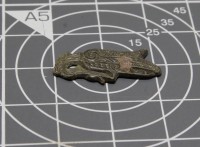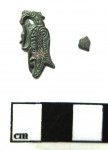 Archaeologists excavating Bamburgh Castle in Northumberland have discovered an artifact whose historical significance is as large as its dimensions are small: a copper alloy fragment decorated with a stylized representation of a bird of a type often found in early medieval art from northern Europe. Just 23mm by 12mm (.9 by .5 inches) in size, the artifact is thin and flat with decoration only on one side. It was likely mounted on a larger object as a decorative element.
Archaeologists excavating Bamburgh Castle in Northumberland have discovered an artifact whose historical significance is as large as its dimensions are small: a copper alloy fragment decorated with a stylized representation of a bird of a type often found in early medieval art from northern Europe. Just 23mm by 12mm (.9 by .5 inches) in size, the artifact is thin and flat with decoration only on one side. It was likely mounted on a larger object as a decorative element.
Harry Francis, part of the Bamburgh Research Project (BRP), found the piece at the end of last summer’s dig season on a cobbled surface just below a 9th century building used for metal working. Archaeologists believe based on the layers that the bird dates to the 8th century. The decorative style is more in keeping with eagle and bird of prey motifs from earlier 6th and 7th century artworks, which makes the bird mount unique with no known parallels in the archaeological record. It’s possible this was a local evolution of Anglo-Saxon art from a century or two before.
In the 8th century, Northumbria was one of about a dozen small kingdoms in the territory that would become unified England under Æthelstan in the 10th century. Bamburgh was a major political and military center in the Kingdom of Northumbria at that time.
Bamburgh Research Project Director, Graeme Young:
“The palace fortress of Bamburgh was one of the most important places in the kingdom and we have evidence of metal working, probably associated with the production of arms and armour for the warriors of the royal court in our excavation.
“In summer 2017 we will continue our investigations of the find spot and we hope to discover if it represents an earlier period of metal working or some other activity.
“At the moment our investigation of this horizon is at such an early stage we are unsure if the find came from within a building or from a yard surface or path where it may have been dropped. We are very much looking forward to getting back on site and continuing our excavations. Who knows what other finds await us this summer!”
 Conservators have been cleaning and stabilizing the bird mount since its discovery, and the first publication on the artifact is scheduled for later this year. Meanwhile, the bird is on display at Bamburgh Castle until October 29th alongside other archaeological materials like swords and elaborately decorated gold pieces unearthed during the project. Bamburgh Research Project archaeologists will be on site between June 11th and 15th and will be available to answer questions and chat about their finds with visitors to the castle.
Conservators have been cleaning and stabilizing the bird mount since its discovery, and the first publication on the artifact is scheduled for later this year. Meanwhile, the bird is on display at Bamburgh Castle until October 29th alongside other archaeological materials like swords and elaborately decorated gold pieces unearthed during the project. Bamburgh Research Project archaeologists will be on site between June 11th and 15th and will be available to answer questions and chat about their finds with visitors to the castle.
That bird from Bamburgh seems to be a heron to me, and the Anglo-Saxon word for heron is ‘hrágra’. Moreover, the piece seems to have fitted a leather belt, horse garter or bridle, so how does this ‘Bamburgh Bird’ compare to the gold plaque known as the ‘Bamburgh Beast’ and the ‘Bamburgh Sword’ ?
————–
“Hér Ida féng to ríce, ðonon Norþanhymbra cyne-cyn onwóc, and ríxode twelf geár. He timbrode Bebban burh, seó wæs ǽrost mid hegge betýned, and ðǽr æfter mid wealle here” (= Ida began to reign, from whom arose the royal race of the Northumbrians, and reigned twelve years. He built Bamburgh, which was at first inclosed by a hedge, and afterwards by a wall)
“Eadfered Flesaurs regnavit duodecim annis in Berneich et alios duodecim in Deur, viginti quattuor annis inter duo regna regnavit et dedit uxori suae Dinguoaroy, quae vocatur Bebbab, et de nomine suae accepit nomen, id est Bebbanburth. Eoguin filius Alli regnavit annis decem et septem et ipse occupavit Elmet et expulit Certic regem illius regionis.”
PUT A BIRD ON IT
This find makes me think of a later King of Northumbria, Edwin (616-632).The venerable Bede told the story of a man who gave this advice to King Edwin: “The present life of man, O king, seems to me, in comparison of that time which is unknown to us, like to the swift flight of a sparrow through the room wherein you sit at supper in winter, with your commanders and ministers, and a good fire in the midst, whilst the storms of rain and snow prevail abroad; the sparrow, I say, flying in at one door, and immediately out at another, whilst he is within, is safe from the wintry storm; but after a short space of fair weather, he immediately vanishes out of your sight, into the dark winter from which he had emerged. So this life of man appears for a short space, but of what went before, or what is to follow, we are utterly ignorant. If, therefore, this new doctrine contains something more certain, it seems justly to deserve to be followed.”
Thou shallst judge a book by the birds on its cover ! 😀
The ‘Lindisfarne Gospels’ are presumed to be the work of a monk named Eadfrith, who became Bishop of Lindisfarne in 698 and died in 721. Here, on f139r, there is a cat depicted that apparently ate some of -remarkably similar- herons.
:chicken: >> >°·°< rrr
PERFECT!
How knowledgeable these readers are!
I am always impressed. 😎
All it takes, is the right electronic devices 😀
However, when you replace some of the ‘P’s with ‘W’s, and read the Lindisfarne Saxon text aloud, you will find a mix of Latin roots, some Dutch, German and English. Hence, a ‘hybrid‘ re-translation from the ‘anglosaxon’ version of Luke 1,1 could then read:
“For that mannige kennende waere(n) busy [acering sod] trying dat hier(e) (ge)interpretedene saga about in us fullfillledene things …” – (cf. folio 139r, i.e. the start of Luke’s gospel )
—————————
Onginneð godspell æft Lucas (‘evanqelium secundum lucam’).
As the text was translated into a Germanic language almost a millennium before Wycliffe or Luther did it,
here Luke 1 in (Greek, Lindisfarne Latin/Saxon [8th c], Wycliffe English [1380s], Luther German [16th c], English, German).
—————————
1 Ἐπειδήπερ πολλοὶ ἐπεχείρησαν ἀνατάξασθαι διήγησιν περὶ τῶν πεπληροφορημένων ἐν ἡμῖν πραγμάτων,
1 Quoniam quidem multi conati sunt ordinare narrationem, quae in nobis completae sunt, rerum,
1 Forðon æcsod monigo cunnendo poeron ƿte hia geendebrednadon ðæt gesaga ðaðe in usic gefylled aron ðingana,
1 Forsothe for manye men enforceden to ordeyne the tellyng of thingis, whiche ben fillid in vs,
1 Syntemal sichs viel unterwunden haben zu stellen die rede von den geschichten, so unter uns ergangen sind
1 Since many have undertaken to set in order a narrative concerning those matters which have been fulfilled among us,
1 Da nun schon Viele unternommen haben, Bericht zu geben von den Geschichten, die sich unter uns erfüllt haben,
2 καθὼς παρέδοσαν ἡμῖν οἱ ἀπ’ ἀρχῆς αὐτόπται καὶ ὑπηρέται γενόμενοι τοῦ λόγου,
2 sicut tradiderunt nobis, qui ab initio ipsi viderunt et ministri fuerunt verbi,
2 suæ gisaldun us ðaðe from fruma ða gesegon embehtmenn perun pordes
2 as thei that seyn atte the bigynnyng, and weren ministris of the word,
2 wie unns das geben haben, die von anfang selbsichtige und diener des wortts gewesen sind,
2 even as those who from the beginning were eyewitnesses and servants of the word delivered them to us,
2 wie uns das überliefert haben, die es von Anfang an selbst gesehen haben und Diener des Wortes gewesen sind,
3 ἔδοξεν κἀμοὶ παρηκολουθηκότι ἄνωθεν πᾶσιν ἀκριβῶς καθεξῆς σοι γράψαι, κράτιστε Θεόφιλε,
3 visum est et mihi, adsecuto a principio omnia, diligenter ex ordine tibi scribere, optime Theophile,
3 gesegen pæs æc me gefylgde fro frua alle georn mið endebrednyse ðe auritta ðu gecorene Theofile,
3 bitaken, it is seen also to me, hauynge alle thingis diligentli bi ordre, to write to thee, thou best Theofile,
3 hab ichs auch fur gutt angesehen, nach dem ichs alles von forne an, mitt fleys erfolget habe, das ichs zu dyr, meyn guter Theophile, ordenlich schrybe,
3 it seemed good to me also, having traced the course of all things accurately from the first, to write to you in order, most excellent Theophilus;
3 habe auch ich’s für gut gehalten, nachdem ich alles von Anfang an sorgfältig erkundet habe, es für dich, hochgeehrter Theophilus, in guter Ordnung aufzuschreiben,
4 ἵνα ἐπιγνῷς περὶ ὧν κατηχήθης λόγων τὴν ἀσφάλειαν.
4 ut cognoscas eorum verborum, de quibus eruditus es, [veritatem/ firmitatem] .
4 ƿte ðu ongette hiora porda on ðæm gelæred arð soðfæstnise.
4 that thou knowe the treuthe of tho wordis, of whiche thou art lerned.
4 auff das du dich erkundigest eynes gewissen grunds, der wort, welcher du unterrichtet bist
4 auf dass du den sicheren Grund der Lehre erfährst, in der du unterrichtet bist.
4 that you might know the certainty concerning the things in which you were instructed.
:hattip:
I am (not) from Barcelona and -as a hobbyist- I really know nothing, but I do nonetheless have a question:
Did Old Luke, who certainly spoke Greek, really address his gospel to a guy called ‘Theophilos’, or just to any ‘God lover’ ?
—————-
“No one knows the true identity of Theophilus and there are several conjectures and traditions around an identity.” 😆
—————-
I wonder, if Martin and all the others wondered who that rather mysterious ‘Theophilos’ would be ? The cat on ‘folio 139’ probably would have known.